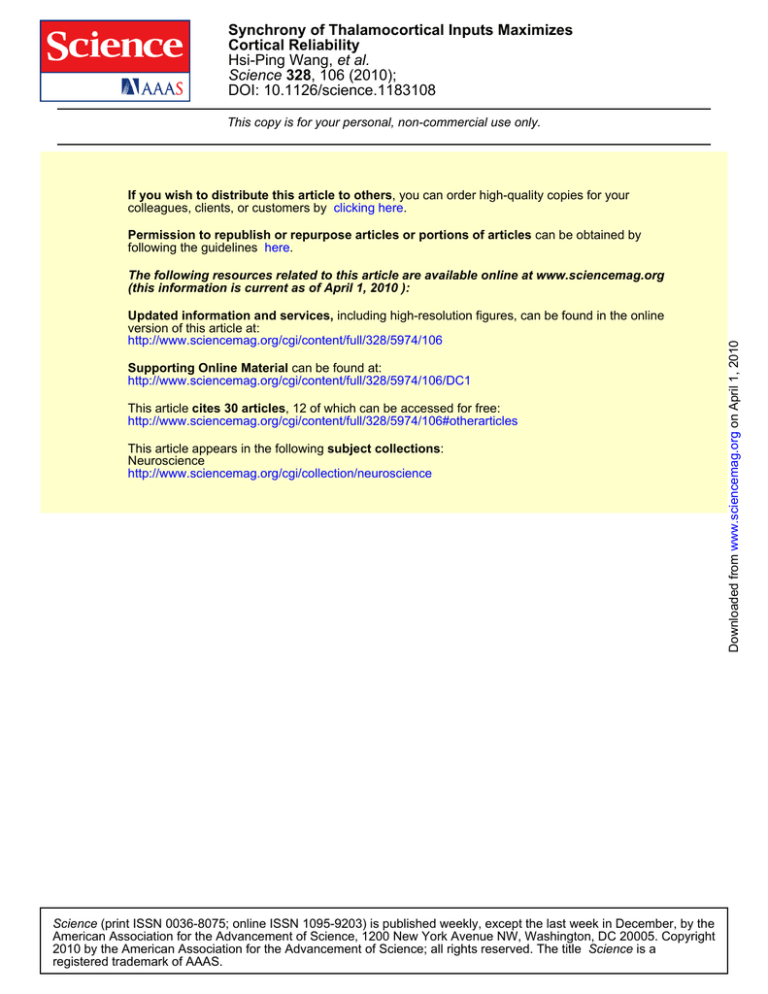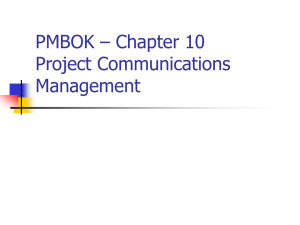
Synchrony of Thalamocortical Inputs Maximizes
Cortical Reliability
Hsi-Ping Wang, et al.
Science 328, 106 (2010);
DOI: 10.1126/science.1183108
This copy is for your personal, non-commercial use only.
If you wish to distribute this article to others, you can order high-quality copies for your
colleagues, clients, or customers by clicking here.
Permission to republish or repurpose articles or portions of articles can be obtained by
following the guidelines here.
Updated information and services, including high-resolution figures, can be found in the online
version of this article at:
http://www.sciencemag.org/cgi/content/full/328/5974/106
Supporting Online Material can be found at:
http://www.sciencemag.org/cgi/content/full/328/5974/106/DC1
This article cites 30 articles, 12 of which can be accessed for free:
http://www.sciencemag.org/cgi/content/full/328/5974/106#otherarticles
This article appears in the following subject collections:
Neuroscience
http://www.sciencemag.org/cgi/collection/neuroscience
Science (print ISSN 0036-8075; online ISSN 1095-9203) is published weekly, except the last week in December, by the
American Association for the Advancement of Science, 1200 New York Avenue NW, Washington, DC 20005. Copyright
2010 by the American Association for the Advancement of Science; all rights reserved. The title Science is a
registered trademark of AAAS.
Downloaded from www.sciencemag.org on April 1, 2010
The following resources related to this article are available online at www.sciencemag.org
(this information is current as of April 1, 2010 ):
that viral infection of circulating cells, for example,
monocytes, can succeed only if the virus prevents
elimination of these cells by virus-specific CTLs.
More work, however, will be required to identify
the cell type supporting superinfection.
Although the biochemical and cell biological functions of US2, US3, US6, and US11
have been studied extensively (18), their role
in viral pathogenesis had remained enigmatic.
Analogous gene functions in murine CMV
(MCMV) had been similarly found to be dispensable for both primary and persistent infection (10), although reduced viral titers have
been reported for MCMV deleted for these
genes (19). Thus, the reason all known CMVs
dedicate multiple gene products to MHC-I downregulation had remained elusive. Our current
results now identify a critical role for these
immunomodulators to enable superinfection
of the CMV-positive host. Furthermore, these
results suggest that the ability to superinfect is
an evolutionary conserved function among
CMVs and therefore might play an important
role in the biology of these viruses. Superinfection could promote the maintenance of
genetic diversity of CMV strains in a highly
infected host population, which could provide
an evolutionary advantage. However, there is
another possibility. CMV is a large virus with
thousands of potential T cell epitopes and
therefore a high potential for CD8+ T cell crossreactivity (20). Indeed, in a study of pan-proteome
HCMV T cell responses, 40% of HCMV seronegative subsets manifested one or more crossreactive CD8+ T cell responses to HCMV-encoded
epitopes (5). As CMV recognition by cytotoxic
T cells appears to effectively block primary CMV
infection, individuals with cross-reactive CD8+ T
cell immunity might be resistant to CMV. Thus,
US2-11 function may be necessary to evade such
responses and establish infection in this large
population of individuals that might otherwise
be CMV-resistant.
Our results also may explain why, so far, it
has not been possible to develop a vaccine
that efficiently protects humans from HCMV
infection. Although antibody-mediated mucosal immunity might reduce the rate of superinfection (7, 21), once this layer of defense is
breached, CMV-specific CTLs seem to be unable to prevent viral dissemination, due to MHC-I
down-regulation by US2-11. Thus, although CMVvaccines might be able to limit CMV viremia
and associated morbidity, this MHC-I interference renders it unlikely that sterilizing protection against CMV infection is an achievable
goal.
References and Notes
1. S. B. Boppana, L. B. Rivera, K. B. Fowler, M. Mach,
W. J. Britt, N. Engl. J. Med. 344, 1366 (2001).
2. S. Gorman et al., J. Gen. Virol. 87, 1123 (2006).
3. S. G. Hansen et al., Nat. Med. 15, 293 (2009).
4. U. Meyer-König, K. Ebert, B. Schrage, S. Pollak,
F. T. Hufert, Lancet 352, 1280 (1998).
5. A. W. Sylwester et al., J. Exp. Med. 202, 673 (2005).
6. S. P. Adler et al., J. Infect. Dis. 171, 26 (1995).
7. S. A. Plotkin, S. E. Starr, H. M. Friedman, E. Gönczöl,
R. E. Weibel, J. Infect. Dis. 159, 860 (1989).
8. Materials and methods are available as supporting
material on Science Online.
9. E. A. Walter et al., N. Engl. J. Med. 333, 1038
(1995).
10. A. K. Pinto, A. B. Hill, Viral Immunol. 18, 434 (2005).
11. F. J. van der Wal, M. Kikkert, E. Wiertz, Curr. Top.
Microbiol. Immunol. 269, 37 (2002).
12. Z. Liu, M. Winkler, B. Biegalke, Int. J. Biochem. Cell Biol.
41, 503 (2009).
13. E. W. Hewitt, S. S. Gupta, P. J. Lehner, EMBO J. 20, 387
(2001).
14. N. T. Pande, C. Powers, K. Ahn, K. Früh, J. Virol. 79, 5786
(2005).
Synchrony of Thalamocortical Inputs
Maximizes Cortical Reliability
Hsi-Ping Wang,1,2* Donald Spencer,1 Jean-Marc Fellous,3 Terrence J. Sejnowski1,2
Thalamic inputs strongly drive neurons in the primary visual cortex, even though these
neurons constitute only ~5% of the synapses on layer 4 spiny stellate simple cells. We modeled
the feedforward excitatory and inhibitory inputs to these cells based on in vivo recordings in cats,
and we found that the reliability of spike transmission increased steeply between 20 and 40
synchronous thalamic inputs in a time window of 5 milliseconds, when the reliability per spike
was most energetically efficient. The optimal range of synchronous inputs was influenced by the
balance of background excitation and inhibition in the cortex, which could gate the flow of
information into the cortex. Ensuring reliable transmission by spike synchrony in small populations
of neurons may be a general principle of cortical function.
eurons can perform coincidence detection of synaptic inputs with a temporal integration window that depends
on the time courses of the synaptic conductances
and the intrinsic properties of the postsynaptic
N
106
neuron (1). Synchronous cortical inputs occur
when there is a salient event in the sensory
environment, such as the entrance of a moving
object into a receptive field (2) or the deflection of a whisker in rodent (3). The precise
2 APRIL 2010
VOL 328
SCIENCE
15. C. J. Powers, K. Früh, PLoS Pathog. 4, e1000150
(2008).
16. R. S. Tirabassi, H. L. Ploegh, J. Virol. 76, 6832
(2002).
17. M. H. Furman, N. Dey, D. Tortorella, H. L. Ploegh, J. Virol.
76, 11753 (2002).
18. C. Powers, V. DeFilippis, D. Malouli, K. Früh, Curr. Top.
Microbiol. Immunol. 325, 333 (2008).
19. A. Krmpotic et al., J. Exp. Med. 190, 1285 (1999).
20. L. K. Selin et al., Immunol. Rev. 211, 164 (2006).
21. R. F. Pass et al., N. Engl. J. Med. 360, 1191 (2009).
22. We are grateful to P. Barry for providing the
RhCMV-GFP and RhCMV-BAC and M. Messerle for
plasmid ori6k-F5. The NIH Nonhuman Primate Reagent
Resource Program provided the CD8a-specific antibody
cM-T807 used in this work (contracts AI040101 and
RR016001), which was originally obtained from
Centocor, Inc. We thank A. Townsend for help with
the graphics. We thank D. Drummond, L. Coyne-Johnson,
M. Spooner Lewis, C. Hughes, N. Whizin, M. Giday,
J. Clock, J. Cook, J. Edgar, J. Dewane, and A. Legasse
for technical assistance. This research was supported
by the National Institutes of Health (RO1 AI059457
to K.F. and RO1 AI060392 to L.J.P.), the International
AIDS Vaccine Initiative (to L.J.P.), the National Center
for Research Resources (RR016025 and RR18107 to
M.K.A.; RR00163 supporting the Oregon National
Primate Research Center), the Ruth L. Kirschstein
National Research Service Awards T32 AI007472 (to
C.J.P.) and T32 HL007781 (to R.R.), the OHSU Tartar
Trust fellowship (to C.J.P.), and the Achievement
Reward for College Scientists (to R.R.). The CMV vector
technology has been patented by Oregon Health and
Science University (US2008/0199493A1) with L.J.P.,
J.A.N., and M.A.J. as coinventors. This patent has been
licensed to the International AIDS Vaccine Initiative.
The comparative genome sequencing data shown in
fig. S5 were deposited in the Gene Expression Omnibus
database (accession number GSE20308).
Supporting Online Material
www.sciencemag.org/cgi/content/full/328/5974/102/DC1
Materials and Methods
Figs. S1 to S5
Table S1
References
1 December 2009; accepted 5 February 2010
10.1126/science.1185350
timing of action potentials has been shown to
potentially provide information in addition to
the spike rate (2, 4–7). For a population of presynaptic neurons to fire nearly simultaneously,
however, requires resources to time spike initiation precisely, parallel anatomical pathways
to carry the spikes, and energy costs for redundant spikes, which may outweigh the benefits of increased information rate (8, 9). We
explored these issues in the projections from the
lateral geniculate nucleus (LGN) to the primary
visual cortex.
The question of efficient information transfer
is particularly important for thalamocortical connections, because thalamic synaptic inputs,
1
Howard Hughes Medical Institute, Computational Neurobiology Laboratory, Salk Institute, La Jolla, CA 92037, USA.
2
Division of Biological Sciences, University of California San
Diego, La Jolla, CA 92093, USA. 3Department of Psychology
and Applied Mathematics Program, University of Arizona,
Tucson, AZ 85721, USA.
*To whom correspondence should be addressed. E-mail:
ping@salk.edu
www.sciencemag.org
Downloaded from www.sciencemag.org on April 1, 2010
REPORTS
REPORTS
MODEL
A
Downloaded from www.sciencemag.org on April 1, 2010
the spike rates of these cells conveyed important information about the input stimulus.
Using spike trains from LGN recordings as inputs to the model cell (21), we also found low
spike-count variability: The Fano factor (FF),
defined as the sample variance divided by sample mean, achieved a minimum of 0.2 to 0.4 in
the range of 20 to 80 synchronous synapses
(fig. S4).
The quantitative analysis of output reliability can be used to predict the number of
synchronous inputs that drive cortical cell
responses during in vivo behavioral experiments (Fig. 3). We plotted data from in vivo
recordings of V1 cells supplied by Kara et al.
(21) against the transfer function of input synchrony as a function of output reliability, as
determined by our model, to infer synchrony
magnitude of the cells in vivo. Each of the four
neurons (from different animals) predicted input synchrony in the range of 20 to 60 synchronous synapses (Fig. 3). The reliability and
Output reliability was a highly nonlinear
function of SM, rising steeply from 20 to a maximum at 40 synapses (Fig. 2A), more rapidly
than the output firing rate (Fig. 2C). The
reliability-per-SM (RPSM) function, defined
by dividing the reliability by the SM, reached
an optimal synchrony magnitude (OSM) at approximately 30 synapses (Fig. 2B, dashed line).
The reliability-per-spike (RPS) ratio, a measure of the reliability increase for each additional output spike computed by dividing each
reliability output by its corresponding firing
rate, also peaked at approximately 30 synchronous synapses (Fig. 2D). Similar results were
obtained when the synaptic inputs were generated from groups of five synchronous inputs
corresponding to single LGN afferents with
each group from a different recorded LGN input
(fig. S2).
In experimental recordings from thalamic
and cortical cells, the trial-to-trial spike-count
variability was low (21, 23), indicating that
MODEL INPUTS
B
Synapse number
V1 Layer 4 Spiny Stellate
LGN
Synchrony magnitude
= 10 synapses
60
D
C
Synchrony magnitude
= 20 synapses
60
40
40
40
20
20
20
0
0
0
50
100 150 200 250
0
50
Synchrony magnitude
= 40 synapses
60
0
100 150 200 250
0
50
100 150 200 250
0
50
100 150 200
MODEL SYNAPTIC RELEASES
E
Synapse number
V1 Layer 4 Interneuron
G
F
60
60
60
40
40
40
20
20
20
0
0
0
50
100 150 200
250
0
0
50
100 150 200
250
250
EXPERIMENTAL
OUTPUT RASTER
Membrane potential (mV)
MODEL OUTPUT MEMBRANE POTENTIALS
H
I
J
-50
-50
-50
-60
-60
-60
-70
-70
-70
-80
0
-80
0
K
Trial number
10
0
100 150 200 250
50
50
100 150 200 250
-80
0
M30
N
30
20
20
20
10
10
10
0
0
L
20
0
50
50
100 150 200 250
50
100 150 200 250
Time (ms)
MODEL OUTPUT RASTERS
30
Trial number
which are comparable in strength to cortical
inputs, constitute only ~5% of the total synaptic
input to cortical simple cells (10–12), but are
nonetheless capable of reliably driving cortical neurons. To examine the relationship between synchrony and reliability, we performed
computer simulations of a detailed biophysical model of a spiny stellate cell in layer 4 of
area V1 (13) of the cat primary visual cortex
(Fig. 1A). This cell received 300 synaptic inputs from the LGN, competing with 5500 other
excitatory and inhibitory intracortical synapses,
including feedforward inhibition. All synapses
were stochastic, and the excitatory synapses included short-term history-dependent modulation of release probability. We used this model
to quantify the number of synchronous synaptic inputs that maximizes the efficient transfer of information to the cortical cell, and we
compared these predictions to experimental
data obtained in vivo from anesthetized cats
(14).
The pairwise correlation strength between
two neurons is often used to estimate their degree of synchrony (15, 16). In the visual thalamocortical pathway, correlated spikes from two
presynaptic LGN neurons strongly increase the
probability of firing in a postsynaptic primary
visual cortex (V1) simple cell (17–19) and ensure
the transfer of information from the thalamus
to the cortex, despite a low probability of synaptic transmission (3, 20). Our simulations support these results by showing that spike output
reliability can be predicted by synchrony magnitude (SM), which is the number of thalamocortical synapses that are simultaneously driven
by the same presynaptic thalamic spike train.
Simultaneous recordings from more than two
LGN neurons would be needed to measure the
SM directly.
We compared the output of our model with
in vivo recordings from Kara et al. (21), who
simultaneously recorded spike trains from
retinal ganglion cells, LGN relay cells, and
cortical cells in the primary visual pathway of
anesthetized cats. The visual stimulus was a
drifting grating, which produced patterns of
spikes without highly synchronous events, as
occurs with flickering visual stimuli (2). The
presynaptic spike times from the in vivo recordings of LGN cells were distributed across a
varying number of input synapses in the model (Fig. 1, B to D), as well as across an inhibitory feedforward pathway leading to the spiny
stellate cell. This pattern was transformed by
the synapses into a sequence of neurotransmitter releases (Fig. 1, E to G) and integrated
with the cortical background inputs to produce
a fluctuating membrane potential (Fig. 1, H to
J, and figs. S1 and S2). The average firing rate
and the reliability (22) of the cortical cell spike
pattern was then computed across 30 repeated
250-ms trials (Fig. 1, K to N), each using a different LGN cell spike pattern from the in vivo
recordings (14).
100 150 200 250
Time (ms)
0
50
100 150 200 250
Time (ms)
30
0
0
50
100 150 200 250
Time (ms)
0
Fig. 1. Varying the synchrony of input synapses affects output reliability and firing rates. (A)
Morphology of a reconstructed V1 layer 4 spiny stellate cell that was modeled with 748 compartments, thalamocortical (TC) synapses with a release probability of P = 0.2 and short-term
plasticity (13, 14), and a feedforward inhibitory interneuron that receives input from LGN and
projects to the spiny stellate cell. (B to D) Rastergrams of 60 thalamocortical synaptic inputs into
the model cell for one trial. An input spike train obtained from in vivo LGN recordings (21)
(referred to as event times) was repeated on a number of input synapses (SM). The input events
were time jittered on average by 1 ms and had 1 out of 10 spikes randomly deleted. (E to G)
Synaptic release rastergram for inputs (B to D). (H to J) Superimposed spiny stellate membrane
potentials from 30 trials. (K) Cortical cell output spike trains from experimental in vivo recordings
(21). (L to N) Rastergrams of outputs from 30 trials of inputs based on different LGN spike trains
from the in vivo data.
www.sciencemag.org
SCIENCE
VOL 328
2 APRIL 2010
107
A
B 0.014
0.45
0.012
0.35
0.03
RPSM
0.25
0.20
0.15
0.010
0.008
0.006
0.10
0.004
0.05
0.002
0
0
100
0
150
0
D
12
0.04
RPS
0.05
8
0.02
2
0.01
100
0
150
Synchrony magnitude (synapses)
100
100
80
80
80
60
60
60
40
40
20
20
0
0
0
0.0
0.2
0.4
Reliability
0.6
0.8
100
C
B
20
50
0
5
10
15
0
20
Firing rate
0.02 0.04 0.06 0.08 0.1
Reliability per spike (RPS)
Fig. 3. Predicted input synchrony ranges for in vivo recordings. Graphs
from Fig. 2 were inverted to make synchrony magnitude the dependent
variable. In each plot, four triangles are positioned along the x axis
(input value), corresponding to in vivo experimentally measured values
from four separate animals (21), and the inferred output synchrony magnitude is shown as a horizontal dashed line from the first intersection on
D
OSM (synapses)
E
80
60
40
20
0
0.0
8
6
4
2
0
0.2
0.4
0.6
0.8
0
0.2
Fano Factor
0.4
0.6
0.8
Reliability
each curve. Predictions were made based on (A) reliability, (B) firing rates,
(C) RPS, and (D) FF (taken from fig. S4C). (E) The predicted firing rate and
reliability at SM = 30 (solid circle with error bars indicating SD) is plotted
along with the measured values from the four sets of recordings (triangles).
Despite the small sample of cells with enough trials, the estimated reliabilities cluster around 0.4.
C
3
40
30
20
10
0
0
5
10
15
20
25
30
Jitter (ms)
B
100
80
2
OSM
(synapses)
1
10
20
30
40
50
60
70
60
40
0
0
20
5
10
Inhibitory input rate (spikes/s)
0
0
200
400
600
800
1000
Feedforward inhibitory strength (synapses)
108
12
10
100
A 50
OSM (synapses)
Fig. 4. Effect of input jitter, inhibitory interneuron strength, and the balance of inhibitory and
excitatory background inputs on the predicted
OSM. (A) The jitter of the input event signals was
varied from 0 to 30 ms. The default used in Figs.
1 to 3 used jitter = 1 ms. (B) The number of
synapses from the feedforward inhibitory interneurons was varied from 0 to 1000 synapses. The
default used in Figs. 1 to 3 was 200 synapses. (C)
The Poisson-distributed presynaptic spike trains for
the 4500 excitatory (glutamate) and 1000 inhibitory (g-aminobutyric acid) intracortical synapses
were covaried from 1 to 3 spikes/s excitatory
background inputs and 1 to 15 spikes/s inhibitory
background inputs. The default in Figs. 1 to 3 was
1 excitatory spike/s and 5 inhibitory spikes/s.
150
Synchrony magnitude (synapses)
Firing rate (spks/s)
50
Synchrony magnitude (synapses)
40
Optimal Synchrony Magnitude
0
0
100
150
0.03
4
0
A
100
0.06
10
6
50
Excitatory input rate (spikes/s)
C
50
Synchrony magnitude (synapses)
Reliability
0.40
Firing rate
Fig. 2. Average spike-time
reliability, firing rate, and efficiency measures as a function of synchrony magnitude
for inputs as described in
Fig. 1. Standard deviation
bars plotted using data from
10 sets of simulations with
30 independent trials each.
(A) Output spike reliability.
(B) RPSM has a peak at a synapse synchrony magnitude
of 30 (vertical dashed line).
(C) Firing rate responses.
(D) RPS efficiency (reliability/
firing rate) also peaked at
30 synchronous synapses.
fluctuations of the membrane potential, which
affected the reliability (23) as well as the gain of
the input spike rate to output spike rate curve
(24). We varied the cortical background rate
and the ratio of inhibitory to excitatory input
rates, b = I/E, to assess their influence on the
reliability of the synchronous inputs to LGN
synapses (Fig. 4C and fig. S3). Background
excitatory inputs above 1 spike/s depressed the
reliability response by directly competing with
the LGN excitatory inputs and introducing high
levels of spurious output firing. Increasing the
background inhibition also increased the OSM
and was therefore a potential mechanism for
setting the threshold for synchrony detection.
The sensitivity of the cortex to synchronous inputs can be varied over a wide range by regulating b.
Spiking due to input synchrony may be a
way to ensure that important events are registered by the spiny stellate neurons in the
cortex, regardless of asynchronously arriving
spikes from ongoing cortical computation.
This prediction could be tested with intracellular recordings in vivo by using a dynamic
clamp (25) to inject somatic conductances reflecting events in the presence of in vivo background noise.
4, A and B, and fig. S4). However, the OSM
depended on the balance between background
excitatory (E) and inhibitory (I) inputs to the
5500 intracortical synapses. When the integrated
inputs were balanced (total average excitatory
input equal to the total average inhibitory input),
the neuron became highly sensitive to correlated
firing rate at the OSM from our model (Fig. 2,
stars), using recorded thalamic input spike trains,
fall within the observed ranges of the experimental values (Fig. 3E).
These results were robust to increasing the
jitter and varying the strengths of thalamic inputs and feedforward inhibitory synapses (Fig.
2 APRIL 2010
VOL 328
SCIENCE
www.sciencemag.org
15
Downloaded from www.sciencemag.org on April 1, 2010
REPORTS
REPORTS
connectivity in other types of neurons. Spike
synchrony, observed throughout the cortex, may
also have a more general function in ensuring
information transmission between cortical areas
(32).
References and Notes
1. E. Salinas, T. J. Sejnowski, Nat. Rev. Neurosci. 2, 539
(2001).
2. P. Reinagel, R. C. Reid, J. Neurosci. 20, 5392 (2000).
3. R. M. Bruno, B. Sakmann, Science 312, 1622 (2006).
4. Y. Dan, J. M. Alonso, W. M. Usrey, R. C. Reid, Nat.
Neurosci. 1, 501 (1998).
5. D. S. Reich, F. Mechler, K. P. Purpura, J. D. Victor,
J. Neurosci. 20, 1964 (2000).
6. W. M. Usrey, Curr. Opin. Neurobiol. 12, 411 (2002).
7. R. D. Kumbhani, M. J. Nolt, L. A. Palmer, J. Neurophysiol.
98, 2647 (2007).
8. D. R. Humphrey, E. M. Schmidt, W. D. Thompson, Science
170, 758 (1970).
9. E. Salinas, L. F. Abbott, J. Comput. Neurosci. 1, 89
(1994).
10. E. L. White, Cortical Circuits: Synaptic Organization of
the Cerebral Cortex—Structure, Function and Theory
(Birkhauser, Boston, 1989).
11. A. Peters, B. R. Payne, Cereb. Cortex 3, 69 (1993).
12. B. Ahmed, J. C. Anderson, R. J. Douglas, K. A. Martin,
J. C. Nelson, J. Comp. Neurol. 341, 39 (1994).
13. Z. F. Mainen, T. J. Sejnowski, Nature 382, 363
(1996).
14. Methods are available as supporting material on Science
Online.
15. W. M. Usrey, Philos. Trans. R. Soc. London Ser. B 357,
1729 (2002).
16. W. M. Usrey, R. C. Reid, Annu. Rev. Physiol. 61, 435
(1999).
17. J. M. Alonso, W. M. Usrey, R. C. Reid, Nature 383, 815
(1996).
18. P. Kara, R. C. Reid, J. Neurosci. 23, 8547 (2003).
www.sciencemag.org
SCIENCE
VOL 328
19. W. M. Usrey, J. M. Alonso, R. C. Reid, J. Neurosci. 20,
5461 (2000).
20. J. de la Rocha, B. Doiron, E. Shea-Brown, K. Josić,
A. Reyes, Nature 448, 802 (2007).
21. P. Kara, P. Reinagel, R. C. Reid, Neuron 27, 635
(2000).
22. S. Schreiber, D. Whitmer, J. M. Fellous, P. Tiesinga,
T. J. Sejnowski, Neurocomputing 52–54, 925 (2003).
23. Z. F. Mainen, T. J. Sejnowski, Science 268, 1503
(1995).
24. E. Salinas, T. J. Sejnowski, J. Neurosci. 20, 6193
(2000).
25. A. A. Sharp, M. B. O’Neil, L. F. Abbott, E. Marder,
J. Neurophysiol. 69, 992 (1993).
26. S. Chatterjee, D. K. Merwine, F. R. Amthor, N. M. Grzywacz,
Vis. Neurosci. 24, 827 (2007).
27. J. E. Hamos, S. C. Van Horn, D. Raczkowski, S. M. Sherman,
J. Comp. Neurol. 259, 165 (1987).
28. T. F. Freund, K. A. C. Martin, D. J. Whitteridge, Comp.
Neurol. 242, 263 (1985).
29. E. Schneidman, M. J. Berry 2nd, R. Segev, W. Bialek,
Nature 440, 1007 (2006).
30. D. A. Butts et al., Nature 449, 92 (2007).
31. N. A. Lesica et al., Neuron 55, 479 (2007).
32. P. Tiesinga, J. M. Fellous, T. J. Sejnowski, Nat. Rev.
Neurosci. 9, 97 (2008).
33. We thank P. Kara, P. Reinagel, and R. C. Reid for sharing
in vivo recordings of simultaneously recorded retinal,
thalamic, and cortical neurons. K. Martin provided
invaluable anatomical data on thalamocortical
connectivity. This research was supported by the Howard
Hughes Medical Institute and the NSF Science of Learning
Center SBE-0542013.
Downloaded from www.sciencemag.org on April 1, 2010
Moving visual inputs give rise to synchronous spikes in retinal ganglion cells (26). A
single retinal ganglion cell can drive four or
more LGN cells (27), which can make one to
eight synapses each (28), with a spiny stellate
cell in V1 with overlapping receptive fields (17).
Thus, assuming an average of four synapses for
each LGN axon and an OSM of 20 to 40, as few
as 5 to 10 LGN cells could effectively drive a
cortical neuron. This prediction could be tested
by studying the effects of modulating the contrast of visual stimuli on the firing rates and reliability of spike timing in cortical cells (21, 29).
Cortical feedback to the thalamus could also
regulate the degree of synchrony among thalamocortical cells.
We have quantified the number of synchronous thalamic spikes needed to reliably report a
major sensory event to cortical neurons (19),
which is consistent with previous physiological
experiments that found correlated firing with
1-ms precision in visual cortex (4, 17) and mouse
barrel cortex (3). Spike synchrony, through
converging anatomical pathways, enhances the
information transfer rate and speeds up processing (30, 31).
The output spike pattern of a layer 4 neuron
is thus determined by the temporal pattern, as
well as the rate, of the synchronous thalamic
inputs according to the history-dependent dynamics of its synapses acting coherently within 6 to 8 ms. The same analytical methods used
here could be applied to study reliability and
Supporting Online Material
www.sciencemag.org/cgi/content/full/328/5974/106/DC1
Materials and Methods
References
9 October 2009; accepted 5 March 2010
10.1126/science.1183108
2 APRIL 2010
109










